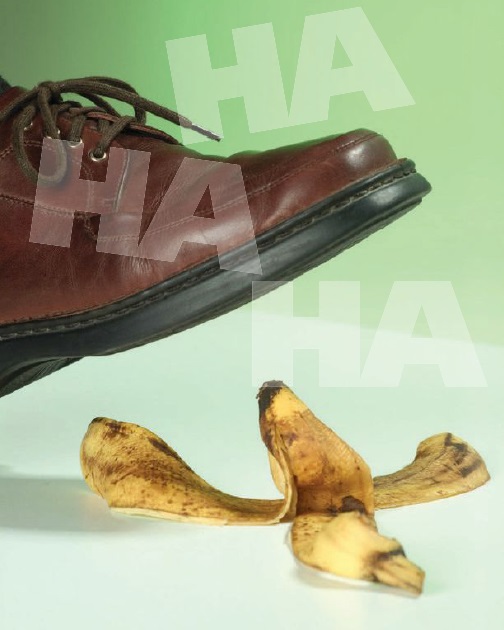Make ’em laugh
Evan Zabawski | TLT From the Editor March 2016
Does tribology validate a comedy staple?

Watching someone else fall down, especially by their own doing, is always funny.
© Can Stock Photo Inc. / ironjohn
SOME OF THE BEST COMEDY IS PERFORMED WITHOUT WORDS—PANTOMIME. Originating in ancient Egyptian times, performers often relied on
schadenfreude (deriving pleasure from the misfortune of others). Harlequin, one of the principle characters from the 16th Century Italian Commedia dell’arte, used a paddle composed of two pieces of wood that slapped together to create a powerful whack using little force. This type of paddle is referred to as a batacchio, which translates to slapstick.
Slapstick comedy, as it is now known, can depend on at least one universal truth: Watching someone else fall down, especially by their own doing, is always funny, and the most popular setup was explained by Cosmo Brown in the movie Singin’ in the Rain, “Just slip on a banana peel; the world’s at your feet.”
Bananas were first imported to New York in 1866 by Carl B. Frank. In 1876, at the first official World’s Fair to be held in the U.S., visitors to the Centennial International Exhibition in Philadelphia were exposed to this new food (wrapped in tin foil and sold for a dime), along with popcorn and Heinz ketchup. Within a few years it became a common street food, eventually replaced by another World’s Fair entry, albeit in Chicago in 1893—the hot dog. I know I digress, but isn’t it odd ketchup was invented before hot dogs?
With a surge in urban migration and a lack of sanitation regulation, people tossing garbage into the streets became a growing concern. Likely due to its large size and distinct color, the banana peel became a symbol of poor manners. By the turn of the century, relying on roaming pigs to dispose of organic matter was no longer reliable. Dan Koeppel’s book Banana: The Fate of the Fruit That Changed the World details the “first large-scale recycling effort in the U.S.” as a public agency headed by a former Civil War colonel, George Waring. His uniformed workers swept the streets of New York and disposed of the waste in public composting facilities.
Relying on the ingrained symbolism, Vaudeville comedians perpetuated the premise that one might still find a banana peel in one’s path, which guaranteed a fall was to follow. The self-proclaimed inventor of the banana-peel pratfall “Sliding” Bill Watson alleged he was inspired by watching a man struggling to maintain his balance after slipping on a peel. This gag was first immortalized on the silver screen by Charlie Chaplin in his 1915 film By The Sea, and later augmented in Buster Keaton’s 1921 film The High Sign, which saw him mockingly step over a banana peel only to slip on a second peel he did not see.
Some evidence suggests that the real slipping hazard in the days of poor sanitation was horse manure, and that the banana peel was simply a visual stand-in contrived for the stage. This has not stopped inquiring minds from performing experiments to confirm the validity of the premise that one can slip on a peel. After all, the June 30, 2002, issue of The Observer stated that Great Britain reported over 300 banana-related accidents in 2001 alone, so there’s got to be some truth in the matter.
The 116th episode of MythBusters, which aired in 2009, tried various experiments with both banana peels and lubricants to test the myth that a banana peel on the ground was guaranteed to cause a fall. The myth was declared busted, but only marginally, since a peel could still prove to be very slippery on a smooth enough surface.
In 2014 Kiyoshi Mabuchi’s team from Kitasato University was awarded the Ig Nobel Prize in the physics category for their paper Frictional Coefficient under Banana Skin, which determined that the coefficient of friction between a banana peel and common floor material is at 0.07 (epidemiological research states the risk of fall exceeds 90% if the frictional coefficient is lower than 0.1). They estimated the dominant factor was the polysaccharide follicular gel (also found in membranes where our bones meet), which becomes a homogeneous sol (a fluid colloidal system) after the peel is crushed. So a fall is possible, just not probable.
 Evan Zabawski, CLS, is a business development/reliability specialist for ALS Tribology in Calgary, Alberta, Canada. You can reach him at evan.zabawski@alsglobal.com
Evan Zabawski, CLS, is a business development/reliability specialist for ALS Tribology in Calgary, Alberta, Canada. You can reach him at evan.zabawski@alsglobal.com.